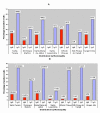Epidemiologic aspects of the malaria transmission cycle in an area of very low incidence in Brazil
- PMID: 17371598
- PMCID: PMC1839104
- DOI: 10.1186/1475-2875-6-33
Epidemiologic aspects of the malaria transmission cycle in an area of very low incidence in Brazil
Abstract
Background: Extra-Amazonian autochthonous Plasmodium vivax infections have been reported in mountainous regions surrounded by the Atlantic Forest in Espírito Santo state, Brazil.
Methods: Sixty-five patients and 1,777 residents were surveyed between April 2001 and March 2004. Laboratory methods included thin and thick smears, multiplex-PCR, immunofluorescent assay (IFA) against P. vivax and Plasmodium malariae crude blood-stage antigens and enzyme-linked immunosorbent assay (ELISA) for antibodies against the P. vivax-complex (P. vivax and variants) and P. malariae/Plasmodium brasilianum circumsporozoite-protein (CSP) antigens.
Results: Average patient age was 35.1 years. Most (78.5%) were males; 64.6% lived in rural areas; 35.4% were farmers; and 12.3% students. There was no relevant history of travel. Ninety-five per cent of the patients were experiencing their first episode of malaria. Laboratory data from 51 patients were consistent with P. vivax infection, which was determined by thin smear. Of these samples, 48 were assayed by multiplex-PCR. Forty-five were positive for P. vivax, confirming the parasitological results, while P. malariae was detected in one sample and two gave negative results. Fifty percent of the 50 patients tested had IgG antibodies against the P. vivax-complex or P. malariae CSP as determined by ELISA. The percentages of residents with IgM and IgG antibodies detected by IFA for P. malariae, P. vivax and Plasmodium falciparum who did not complain of malaria symptoms at the time blood was collected were 30.1% and 56.5%, 6.2% and 37.7%, and 13.5% and 13%, respectively. The same sera that reacted to P. vivax also reacted to P. malariae. The following numbers of samples were positive in multiplex-PCR: 23 for P. vivax; 15 for P. malariae; 9 for P. falciparum and only one for P. falciparum and P. malariae. All thin and thick smears were negative. ELISA against CSP antigens was positive in 25.4%, 6.3%, 10.7% and 15.1% of the samples tested for "classical" P. vivax (VK210), VK247, P. vivax-like and P. malariae, respectively. Anopheline captures in the transmission area revealed only zoophilic and exophilic species.
Conclusion: The low incidence of malaria cases, the finding of asymptomatic inhabitants and the geographic separation of patients allied to serological and molecular results raise the possibility of the existence of a simian reservoir in these areas.
Figures




Similar articles
-
Malaria epidemiology in low-endemicity areas of the Atlantic Forest in the Vale do Ribeira, São Paulo, Brazil.Acta Trop. 2006 Nov;100(1-2):54-62. doi: 10.1016/j.actatropica.2006.09.010. Acta Trop. 2006. PMID: 17126279
-
Detection of etiological agents of malaria in howler monkeys from Atlantic Forests, rescued in regions of São Paulo city, Brazil.J Med Primatol. 2011 Dec;40(6):392-400. doi: 10.1111/j.1600-0684.2011.00498.x. Epub 2011 Sep 20. J Med Primatol. 2011. PMID: 21933192
-
Widespread occurrence of antibodies against circumsporozoite protein and against blood forms of Plasmodium vivax, P. falciparum and P. malariae in Brazilian wild monkeys.J Med Primatol. 2006 Apr;35(2):87-96. doi: 10.1111/j.1600-0684.2006.00148.x. J Med Primatol. 2006. PMID: 16556295
-
Modern immunological approaches to assess malaria transmission and immunity and to diagnose plasmodial infection.Mem Inst Oswaldo Cruz. 1992;87 Suppl 5:117-24. doi: 10.1590/s0074-02761992000900018. Mem Inst Oswaldo Cruz. 1992. PMID: 1342707 Review.
-
Molecular characterisation of airport malaria: four cases in France during summer 1999.Parasite. 2002 Jun;9(2):187-91. doi: 10.1051/parasite/2002092187. Parasite. 2002. PMID: 12116866 Review.
Cited by
-
Asymptomatic malaria, growth status, and anaemia among children in Lao People's Democratic Republic: a cross-sectional study.Malar J. 2016 Oct 18;15(1):499. doi: 10.1186/s12936-016-1548-3. Malar J. 2016. PMID: 27756399 Free PMC article.
-
Biodiversity can help prevent malaria outbreaks in tropical forests.PLoS Negl Trop Dis. 2013;7(3):e2139. doi: 10.1371/journal.pntd.0002139. Epub 2013 Mar 21. PLoS Negl Trop Dis. 2013. PMID: 23556023 Free PMC article.
-
Plasmodium simium: Population Genomics Reveals the Origin of a Reverse Zoonosis.J Infect Dis. 2021 Dec 1;224(11):1950-1961. doi: 10.1093/infdis/jiab214. J Infect Dis. 2021. PMID: 33870436 Free PMC article.
-
Natural infection in anopheline species and its implications for autochthonous malaria in the Atlantic Forest in Brazil.Parasit Vectors. 2013 Mar 7;6:58. doi: 10.1186/1756-3305-6-58. Parasit Vectors. 2013. PMID: 23497493 Free PMC article.
-
Comparison of the antibody responses to Plasmodium vivax and Plasmodium falciparum antigens in residents of Mandalay, Myanmar.Malar J. 2011 Aug 6;10:228. doi: 10.1186/1475-2875-10-228. Malar J. 2011. PMID: 21819610 Free PMC article.
References
-
- U.S. Department of Health and Human Services Centers for Disease Control and Prevention, 2004. A-Z Index: Malaria. About Malaria, Malaria Facts: Global Distribution http://www.cdc.gov/malaria/facts.htm#WorldMalaria
-
- Diretoria Técnica da Gestão, Secretaria de Vigilância em Saúde, Ministério da Saúde . Situação Epidemiológica da Malária no Brasil. Ministério da Saúde, Brasília; 2005.
-
- World Health Organization . Basic malaria microscopy. World Health Organization, Geneva; 1991.
Publication types
MeSH terms
Substances
LinkOut - more resources
Full Text Sources
Medical
Miscellaneous

